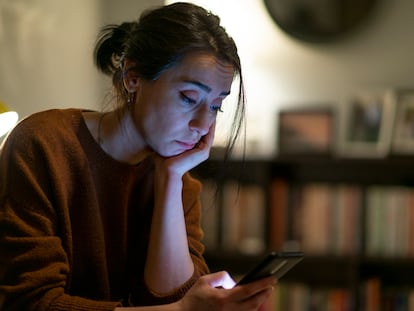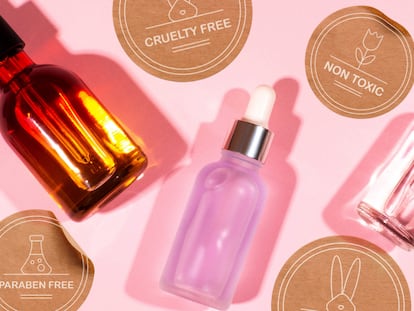Marcos Nadal, psychologist: ‘Pleasure is conditioned by your experience, expectations and context’
The researcher, who is a specialist in neuroesthetics, studies the neurobiological mechanisms that are set in motion whenever you perceive something as being beautiful

When you come across something that you consider to be truly beautiful — be it a song, a person, or a work of art — it’s because a handful of neurons tune in and work together to give off that pleasant feeling. The science that studies this phenomenon, known as “neuroesthetics,” is a relatively new discipline, admits Marcos Nadal, a Spanish researcher. He works at the Human Evolution and Cognition Group at the University of the Balearic Islands on the island of Majorca. The 47-year-old psychologist has noticed that not one, but several parts of the brain are involved in the perception of beauty.
Nadal has visited Barcelona to participate in a series of conferences titled The logic of beauty, organized by CosmoCaixa, a local science museum. “Beauty isn’t a quality that resides in objects. Rather, it’s a quality [dependent on] our experience of it,” he tells an attentive audience. Believing that color, sound or beauty are attributes of objects is, according to him, “naive realism.”
“We’re not collectors of reality, but interpreters,” he explains. He also warns that beauty isn’t trivial — it influences behavior, emotions and decisions. Nadal offers a clear example of this: there are studies that have shown that, when faced with attractive students, teachers have a certain bias, valuing their academic possibilities more, giving out better grades and perceiving them as more competent. The students are also more popular.
Question. What does beauty mean?
Answer. It’s a philosophical concept that comes from classical Greece. But not all philosophical concepts fit well into the conceptual schemes of psychology and neuroscience. Beauty is one of these exceptions. Why? Because we don’t find mental processes or neural mechanisms that are specific to the experience of beauty. The first lesson that psychologists and neuroscientists draw is that this experience — which we call beauty — is equivalent, in practically everything, to other experiences that we find pleasant.
Q. So essentially, beauty is pleasure.
A. Yes, but not only pleasure. An experience of beauty is almost always going to be pleasant. Beauty is something that emerges from complex neural systems that are dedicated to generating pleasurable experiences in other areas of life, such as the pleasure of sex, company or drugs.
Q. How does this system work? Because whatever can be beautiful or pleasant for one person won’t be for another. For example, someone may like French fries, while someone else prefers broccoli.
A. This is a [neurological] system that works by anticipating objects, situations and environments that are going to be pleasant and measuring the difference between real pleasure and anticipated pleasure, generating the subjective experience. It’s a very contextual kind of mental processing: you may like French fries, but if you eat two buckets from McDonald’s, eating one more will make you sick, because of satiation. Satiation is a factor that affects the functioning of this neural system: the brain says that “this is no longer pleasant.” It’s a system that works by analyzing what can be good for your body at a certain time. What makes something beautiful to one person and not beautiful to another? Well, the experiences that you’ve had throughout your life have conditioned [your] system of [processing] pleasure.
Q. So beauty depends on our personal experience?
A. Very much so, as with any pleasure. It depends on your personal experience, the context you’re in, what you anticipate. The same movie seen in the cinema, at home, with people making a lot of noise, or by yourself changes [according to how you] experience pleasure [and what you prefer].
Q. You said that beauty is pleasure, but not only pleasure. What else does it consist of?
A. That’s the part we don’t understand very clearly. In the case of beauty, there seems to be a formula regarding what we mean when we say that something is beautiful. We’ve learned that, in our culture, there are certain patterns of what represents beauty. So, it seems that, in addition to this pleasure, there is — due to the internalization of learning in each culture — a canon that you compare with the object that gives you pleasure. The moment they fit together, you say that “this is beautiful.”
These patterns change over time. One exercise that I do with my students is to go over the covers of People magazine’s “World’s Sexiest Man Alive.” Clearly, from the 1980s until today, the canon of beauty has changed a lot. But it has changed within certain margins.
Q. What happens inside the brain when we perceive something as being beautiful?
A. There are many studies in music that analyze what occurs in the brain when a person experiences a piece of music and [finds it to be] beautiful. What happens is that the activity of the neurons in the auditory system — which is processing the musical aspects of that fragment — is synchronized with [other parts of the brain] that process different aspects of pleasure. For example, there’s an interface called the nucleus accumbens, which is responsible for generating pleasant sensations, but also for anticipating them. Anticipation generates a series of responses [that are pleasurable]. At the same time, the amygdala is generating states of activation of the body; your physiological systems are activated [by] pleasure. The orbitofrontal cortex processes what’s called the reinforcement value, which is how much you enjoy the sensation. And the ventromedial cortex is the one that is in charge of transmitting the bodily sensations of that pleasure.
Q. Can this process be transformed? That is to say, perhaps you love a song at first, but maybe you listen to it so much that it ends up being boring…
A. There’s an intermediate point of familiarity where that pleasure is [at its] maximum [level]. That is to say, at first, [the song] doesn’t sound familiar to you, you don’t quite understand the music, it’s very new... But, you listen to it a couple of times, you make it yours, and that pleasure is maximum. Although later, satiation occurs. There’s a middle ground where uncertainty meets predictability: there’s enough uncertainty to make this interesting to you, but at the same time, it’s predictable. When you’ve listened to the song many times, the degree of uncertainty is zero and the degree of predictability is absolute.
Your musical tastes — and your previous experiences with that song — greatly determine that degree of pleasure. Your experience of pleasure is conditioned by three factors: your previous experience, the expectations you have and the context in which you’re living. Beauty isn’t special in that sense.
Q. Can context modulate your entire perception of beauty? For instance, bell-bottoms were worn in the 2000s, then they fell out of favor. Today, they’re back. To what extent is it genuine that someone likes to dress in a certain way?
A. What is genuine is [often] conditioned by others. You may see a person who is super attractive to you, but then you meet them and find them unpleasant. Firsthand knowledge changes the way you see that person — you may even see them as ugly [after a negative interaction]. And it also happens the other way around. Beauty isn’t simply a response to some qualities of an object. Beauty is an experience. We build it by taking into account the qualities of an object, but many more things along with it. The experience of beauty is never isolated; it’s always immersed in the life of a person, in its context.
Q. Is there a generational change in the perception of beauty?
A. The way of perceiving beauty is the same, but we change what we’re going to give positive value to. Why? Because we have new models [of beauty]. Each one of us has internalized a reference of what beautiful means. And that model is always changing.
Q. Can widespread social media and perfection-seeking filters have an impact on the perception of beauty?
A. It has a very big impact. Our beauty appreciation system feeds on specimens that we see throughout our lives and that we share with other people. 50 years ago, people moved in their town, in their circle, in their neighborhood… There were fewer specimens of beauty. Now, we get examples from all over the world: the range of the most beautiful specimens opens up. And it’s further expanded with the ability to apply filters to those images and, therefore, exaggerate features that we consider beautiful and enhance what our brain identifies as beautiful. Beauty is exaggerated.
What happens after that? Well, there’s a tension between your real world — that of the people you associate with on a daily basis — and the references that come to you through social media, which are exaggerated. There’s a growing tension between the beauty you see in the mirror and the beauty you see in those images online. This can generate dissatisfaction with one’s self-image and, perhaps, also with the image that you expect your girlfriend or boyfriend to have, because it doesn’t quite satisfy that ultra-filtered and ultra-exaggerated model, which continues to be a falsification of reality.
Sign up for our weekly newsletter to get more English-language news coverage from EL PAÍS USA Edition
Tu suscripción se está usando en otro dispositivo
¿Quieres añadir otro usuario a tu suscripción?
Si continúas leyendo en este dispositivo, no se podrá leer en el otro.
FlechaTu suscripción se está usando en otro dispositivo y solo puedes acceder a EL PAÍS desde un dispositivo a la vez.
Si quieres compartir tu cuenta, cambia tu suscripción a la modalidad Premium, así podrás añadir otro usuario. Cada uno accederá con su propia cuenta de email, lo que os permitirá personalizar vuestra experiencia en EL PAÍS.
¿Tienes una suscripción de empresa? Accede aquí para contratar más cuentas.
En el caso de no saber quién está usando tu cuenta, te recomendamos cambiar tu contraseña aquí.
Si decides continuar compartiendo tu cuenta, este mensaje se mostrará en tu dispositivo y en el de la otra persona que está usando tu cuenta de forma indefinida, afectando a tu experiencia de lectura. Puedes consultar aquí los términos y condiciones de la suscripción digital.
More information
Últimas noticias
From digital curfews to blocking apps: How technology experts protect their children online
Why the price of coffee has skyrocketed: from Brazilian plantations to specialty coffee houses
Confined to a Cuban hospital: When electricity is a matter of life or death
The complicated life of Francesca Albanese: A rising figure in Italy but barred from every bank by Trump’s sanctions
Most viewed
- Why we lost the habit of sleeping in two segments and how that changed our sense of time
- Trump’s obsession with putting his name on everything is unprecedented in the United States
- Pablo Escobar’s hippos: A serious environmental problem, 40 years on
- The Florida Keys tourist paradise is besieged by immigration agents: ‘We’ve never seen anything like this’
- Charles Dubouloz, mountaineering star, retires at 36 with a farewell tour inspired by Walter Bonatti










































